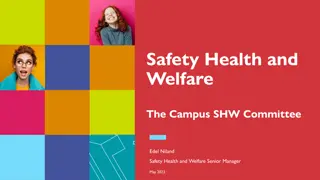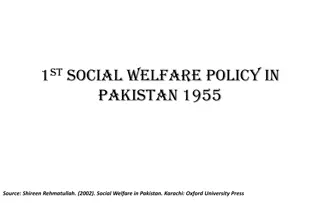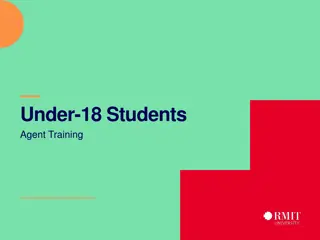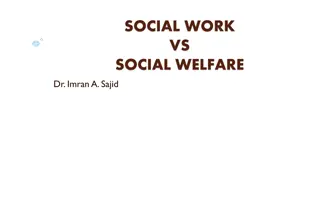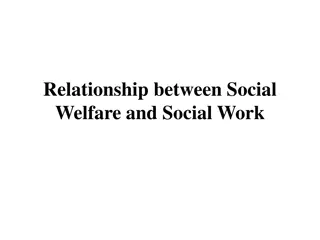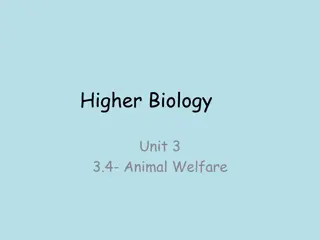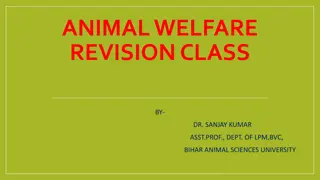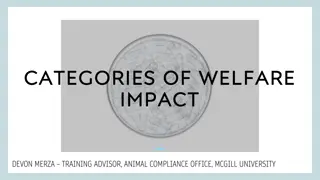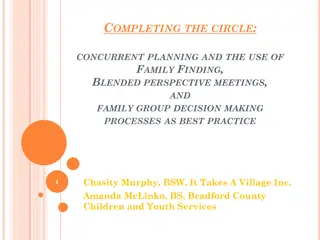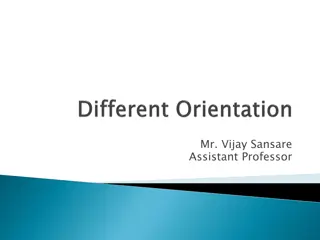Reforming Welfare System for Enhanced Effectiveness
The current welfare system in the United States faces critical shortcomings, including promoting short-term consumption over self-sufficiency, causing financial fragility, and imposing high effective marginal tax rates on recipients. Key programs like TANF, SNAP, and Medicaid aim to assist needy families, but there is a need for reform to ensure these programs effectively target those in need. Kentucky's utilization of TANF funds primarily for basic assistance highlights the disparity in fund allocation among states, emphasizing the necessity for strategic welfare reform measures.
Download Presentation

Please find below an Image/Link to download the presentation.
The content on the website is provided AS IS for your information and personal use only. It may not be sold, licensed, or shared on other websites without obtaining consent from the author. Download presentation by click this link. If you encounter any issues during the download, it is possible that the publisher has removed the file from their server.
E N D
Presentation Transcript
THE NEED FOR WELFARE REFORM Anne-Tyler Morgan, Esq. Member, McBrayer, PLLC Senior Fellow, Pegasus Institute
COMMON-SENSE MEASURES TO TARGET THE ADMINISTRATION OF KENTUCKY S WELFARE SYSTEM TO THOSE SERVICES THAT KENTUCKIANS NEED MOST The lessons of history show conclusively that continued dependency upon relief induces a spiritual and moral disintegration fundamentally destructive to the national fiber. President Franklin D. Roosevelt, 1935 Our current welfare system is comprised of approximately 100 different federal programs. This system suffers three fatal shortcomings: prefers current consumption to future self-sufficiency (or giving a man fish rather than teaching him to fish himself) causes financial fragility by forcing recipients to run through the vast majority of their assets prior to receiving benefits penalizes recipients through high effective marginal tax rates as they attempt to escape poverty and earn higher incomes Dorfman, Jeffrey, Forbes, Welfare Offers Short-Term Help and Long-Term Poverty, Thanks to Asset Tests , October 13, 2016, <https://www.forbes.com/sites/jeffreydorfman/2016/10/13/welfare-offers-short-term-help-and-long-term-poverty/#6236602332cd>, last accessed February 25, 2019.
KEY PROGRAMS TO AFFECT IN KENTUCKY TANF TANF stands for Temporary Assistance for Needy Families. The TANF program, which is time limited, assists families with children when the parents or other responsible relatives cannot provide for the family's basic needs. SNAP SNAP stands for the Supplemental Nutrition Assistance Program. It is a federal nutrition program that helps you stretch your food budget and buy healthy food. Medicaid Medicaid provides health coverage to millions of Americans, including eligible low-income adults, children, pregnant women, elderly adults and people with disabilities.
TANF TANF was created through the Personal Responsibility and Work Opportunity Reconciliation Act of 1996 [emphasis added] as part of federal effort to end welfare as we know it under President Bill Clinton. So far in its implementation, Kentucky has largely failed to fulfill the central mission of the federal program. By federal law, states can use TANF dollars to: Provide assistance to needy families so that children may be cared for in their own homes or in the homes of relatives End the dependence of needy parents on government benefits by promoting job preparation, work, and marriage Prevent and reduce the incidence of out of wedlock pregnancies and establish annual numerical goals for preventing and reducing the incidence of these pregnancies Encourage the formation and maintenance of two parent families
TANF (CONTD.) Kentucky is one of only two states in the nation that devoted the majority of its TANF funds to basic assistance (i.e. cash benefits) in 2017. The majority of states distribute TANF funds among such uses as child care, child welfare, work training, and support services, with only a small minority of most states funds going to basic cash assistance. TANF and MOE Spending and Transfers by Activity, FY 2017 , U.S. Department of Health and Human Services, <https://www.acf.hhs.gov/sites/default/files/ofa/fy2017_tanf_and_moe_state_piechart.pdf>, last accessed February 25, 2019. Recommended distribution of Kentucky TANF funds: 25% of program funds to work, education, and training programs; 25% to work and supportive services; 25% to child care needed to help many low-income parents establish and maintain employment; 15% to basic assistance; 10% to short-term assistance; and 5% to program maintenance. The more tailored use of TANF funds would not remove such funds from low-income recipients; they would more effectively serve such recipients and lift them from the low-income status that traditional basic assistance merely maintains. Importantly, 25% of TANF funds would continue to be used for short-term or long-term cash benefits for those who need them most.
TANF RECOMMENDATIONS CONSISTENT WITH FEDERAL LAW Recommendations are consistent with the comprehensive five-year TANF reauthorization bill approved by the U.S. House Ways and Means Committee in May 2018. That bill called for more universal engagement of adults on welfare in work and training and other productive activities while receiving benefits, and also proposed holding states accountable for their success in assisting able-bodied adults in leaving welfare as a result of entering, remaining, and advancing in work. Those principles remain a key part of the reauthorization discussion still ongoing in Washington, DC. Work and the income that it provides families are the only long- run solution to poverty, and you are to be commended for taking steps to improve the work-supporting effects of the TANF program in Kentucky. Low-income adults and their families will directly benefit. And taxpayer confidence that the TANF program promotes work and self-sufficiency, instead of prolonged welfare receipt, will be strengthened as well. -American Enterprise Institute ( AEI ) Resident Fellow Matt Weidlinger
SNAP In FY16, Kentucky s state share of administrative costs to support SNAP exceeded $60 million. In the same fiscal year, Kentucky completed 408 positive post-certification investigations, totaling over $2.3 million in identified fraud dollars . Supplemental Nutrition Assistance Program State Activity Report Fiscal Year 2016 , Food and Nutrition Service, Supplemental Nutrition Assistance Program, Program Accountability and Administration Division, September 2017, <https://fns-prod.azureedge.net/sites/default/files/snap/FY16-State- Activity-Report.pdf>, last accessed February 26, 2019. Matt Weidlinger, who serves as an American Enterprise Institute ( AEI ) Resident Fellow, has additionally stated that SNAP error rates exceeded six percent in 2017 alone. When SNAP dollars are spent fraudulently, they (1) are taken from their intended purpose: to buy food for low-income individuals to prevent hunger; and (2) are used for other unauthorized purposes which may work to the detriment of the very population that SNAP is intended to serve, such as secondary market sales.
SNAP (CONTD.) Recommendation: Require substance abuse testing only for those individuals with a felony or misdemeanor history of substance abuse Upon a positive test, provide a grace period schedule during which a SNAP participant will continue to receive benefits and be provided with a list of licensed substance abuse treatment providers available in his or her area Mandate that no dependent children will be affected by a parent or guardian s positive drug screen under this SNAP requirement; a parent or guardian may mitigate a positive drug screen by designating another appropriate individual to receive benefits on behalf of a minor child or children. Serves dual purpose: also helps identify and encourage individuals needing treatment - especially important given Kentucky s rank among the top ten states in the nation for opioid-related overdose deaths (nearly double the average rate) Kentucky Opioid Summary , National Institute on Drug Abuse, Revised February 2018, <https://www.drugabuse.gov/drugs-abuse/opioids/opioid-summaries-by- state/kentucky-opioid-summary> , last accessed February 26, 2019.
SNAP (CONTD.) Recommendation: Require working-age, able-bodied parents of children from ages six to 17 who partake in the SNAP program to participate in community engagement activities such as work, job training, education, or volunteering each month Such community engagement by parents models healthy work behavior for their children, promotes employment and higher family incomes, and works to end the cycle of generational dependency. Only parents of children over six years of age would be subject to the requirements.
SNAP (CONTD.) Under federal law, Kentucky can require SNAP EBT cards to include photo identification to reduce fraud, waste, and abuse. Results/studies so far indicate that this requirement would be of limited (if any) value because: Entire family may use EBT card Federal regulations require equal treatment by retailers, so everybody at the grocery would need to show ID Main type of SNAP fraud is trading cash for false transactions, for which a photo ID wouldn t make a difference Why Photo IDs Won t Stop Food Stamp Fraud , J.B. Wogan, Governing, April 14, 2015.
MEDICAID 21% of Kentucky population is covered by Medicaid or CHIP, or 1 in 6 adults. 462,000 adults are in the expansion population , or those individuals with incomes up to 138% of the federal poverty level (regardless of medical frailty or condition) Medicaid in Kentucky , Kaiser Family Foundation, November 2018, <http://files.kff.org/attachment/fact-sheet- medicaid-state-KY> last accessed June 28, 2019. Kentucky spent over $9.6 billion on Medicaid services in FY16. What are Annual Expenditures for Medicaid & CHIP? Centers for Medicare & Medicaid Services, <https://www.medicaid.gov/state-overviews/scorecard/national-context/annual-expenditures/index.html>, last accessed June 28, 2019.
MEDICAID (CONTD.) Recommendation: Codify community engagement and cost-sharing requirements for working-age, able-bodied Medicaid participants to offer each participant the ability to customize their healthcare path, leading to better health, civic engagement, increased employability, and improved self- sustainability over time. Would grant Medicaid beneficiaries the opportunity to utilize the Commonwealth s resources, such as its Kentucky Career Centers, to participate in job training and educational activities and gain access to the private insurance market when they are ready. Civic engagement such as volunteer work and caregiving may also satisfy a beneficiary s community engagement requirements, improving a participant s social determinants of health.


